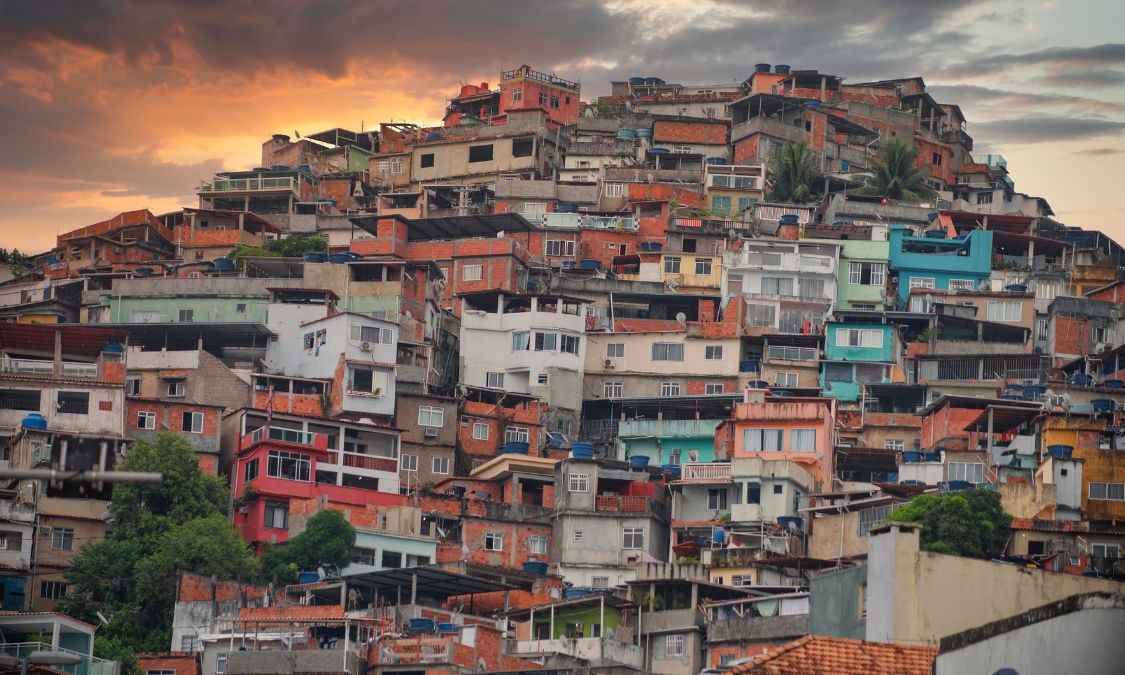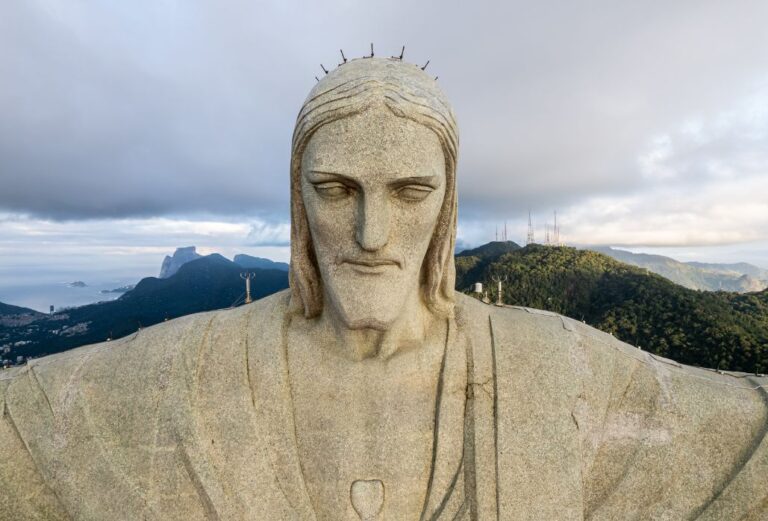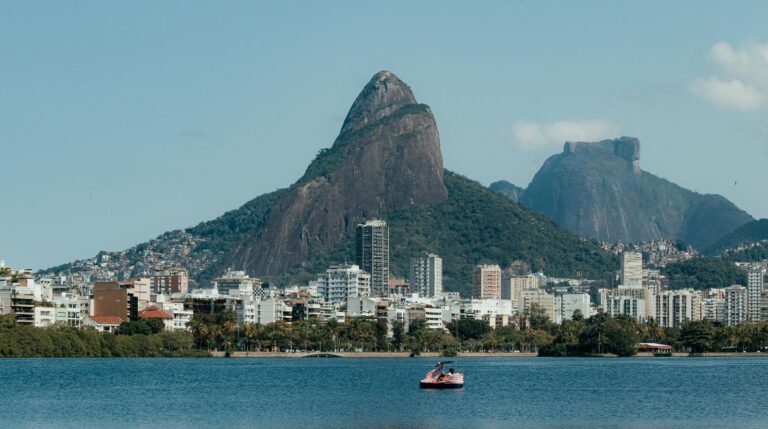5 Best Favela Tours in Rio: A Complete Guide [2024]
LOOKING FOR THE BEST RIO FAVELA TOUR?
You are in the right place, as we will be talking all about favela tours in Rio de Janeiro. Back in 2016, I lived in the Vidigal favela for about six months. I also volunteered for a company called Favela Experience, which granted me the ability to visit several favelas in the Zona Sul.
The reality is that Rio de Janeiro favelas are an inescapable part of the Rio landscape and are synonymous with the city itself. Rio is home to around 600 different favelas, most of which are not safe to visit. However, there are a couple that do offer tours. So how do you choose the right favela tour?
Following the pacification of the favelas that began in 2008, tourism grew in popularity, and there are many companies that offer tours to visit them. But how do you choose the right one?
Top 5 Favela Tours in Rio
Above all else, if you are interested in visiting a favela, I’d recommend sticking to Vidigal, Rocinha, and Santa Marta; those are the ones that have tours run by locals. Here are a couple of my favorite favela tours in Rio that are ethical, responsible, and run by locals that live in the favela itself.
⚠️ Note: Please avoid calling favelas Rio de Janeiro slums or Rio slums. Instead, opt for the word communities or urban spaces.
1. Rio De Janeiro: Half-Day Rocinha Favela Walking Tour

⭐️ Rating: 4.7 out of 5 Stars | ⏰ Tour time: 4 hours | 📍 Check rates & availability
Venture into the heart of Rio’s largest favela, Rocinha, on a half-day walking tour that challenges stereotypes and provides an authentic perspective on local life.
Organized by local, English-speaking guides and favela hosts, this walking tour is designed to be respectful and non-intrusive to the residents.
This experience was amazing, the guide really knew where to go and what to see. This is a must-do cultural experience for anyone visiting Rio!
—SIMON (READ MORE REVIEWS)
Unlike other tours that merely drive around in jeeps, this walking tour allows you to stroll the streets in small groups, interact with the locals, and hear their stories firsthand. You’ll learn about the favela’s history, its social and economic challenges, and the vibrant community that calls it home.
The cost of the tour also includes a contribution to the favela community, adding an element of responsible tourism to your visit.
2. Rio de Janeiro: Favela Santa Marta Tour with a Local Guide

⭐️ Rating: 4.9 out of 5 Stars | ⏰ Tour time: 2.5 hours | 📍 Check rates & availability
Experience a slice of authentic Rio de Janeiro with a guided tour of Favela Santa Marta. Led by a local resident, Thiago Firmo, who was born and raised in Favela Santa Marta, this tour offers an authentic exploration of the favela’s vibrant culture and daily life.
From the panoramic views of iconic landmarks such as Christ the Redeemer and Sugar Loaf Mountain, reached by the Santa Marta cable car, to the bustling streets that have hosted famed guests like Queen Elizabeth II and Michael Jackson, you’ll experience the favela from a truly unique perspective.
This was an incredible tour – I’m recommending it to any and all of my friends who come to Rio.
—CHRISTINE (READ MORE REVIEWS)
The tour also offers a chance to visit local artisan shops, revealing the favela’s creative spirit. You’ll walk away with a richer understanding of Rio’s favelas, making this an unforgettable experience for any traveler seeking a deeper connection with the city’s diverse communities.
3. Rio de Janeiro: Vidigal Favela Tour & Two Brothers Hike

⭐️ Rating: 4.6 out of 5 Stars | ⏰ Tour time: 5 hours | 📍 Check rates & availability
Embrace an off-the-beaten-path adventure in Rio de Janeiro by exploring the captivating Vidigal favela. This community, which emerged around 1940, offers a unique blend of history, culture, and stunning Atlantic Ocean views.
Your journey begins in Vidigal, where you’ll immerse yourself in the community, using local transport and engaging with residents.
The walk through the favelas of Vidigal was an impressive experience and Eduardo took us to a nice bar with an amazing view.
—REVIEWER (READ MORE REVIEWS)
Follow your guide in a group through the forest and head to the first viewpoint. Continue to the next viewpoint for a breathtaking view of Pedra da Gávea and Pedra Bonita. See Corcovado in the other direction before going to the summit of Two Brothers Hill (Morro Dois Irmaos).
The summit reveals a panoramic vista of Rio’s famous beaches, including Leblon, Ipanema, and Copacabana. This 4.5-hour hike is a true adventure, while also providing travelers a deeper understanding of Rio’s social divisions.
4. Favela Tour Rocinha and Vila Canoas in Rio de Janeiro

⭐️ Rating: 4.5 out of 5 Stars | ⏰ Tour time: 3 hours | 📍 Check rates & availability
Experience an intimate look at local life in Rio de Janeiro through a guided tour of Rocinha and Vila Canoas, two of the largest favelas in the city.
You’ll begin in Rocinha, where you’ll learn about the favela’s unique architecture, public services, and cultural aspects, stopping at the Rocinha handcraft center and a local terrace for breathtaking views.
This experience was amazing, the guide really knew where to go and what to see. This is a must-do cultural experience for anyone visiting Rio!
—SIMON (READ MORE REVIEWS)
A highlight of the tour is the visit to community schools like Moranguinhos or Saci Sabe Tudo. Funded by Favela Tour, these schools offer local kids classes in computer skills, English, music, capoeira, and ballet.
With the convenience of hotel pickup and drop-off included, this tour offers a rare and valuable insight into a side of Rio few visitors get to see.
5. Favela Tour in Rio with Transfer service
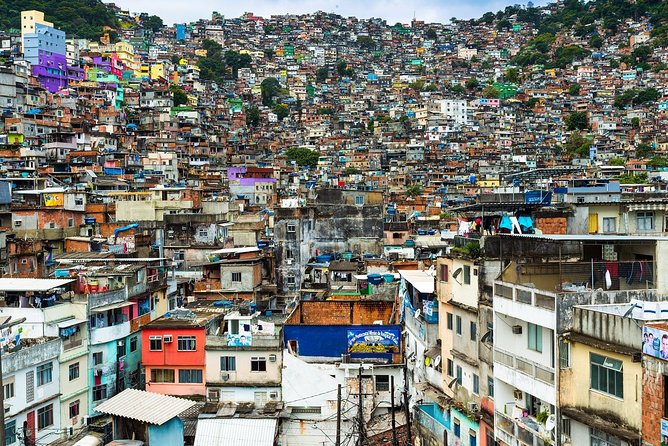
⭐️ Rating: 4.5 out of 5 Stars | ⏰ Tour time: 3 hours | 📍 Check rates & availability
Uncover the complexities of life in Rocinha Favela, Latin America’s largest favela, during this 3-hour educational tour.
Guided by a local, you’ll navigate the vibrant community, engage with its residents, and delve into the rich history of Rocinha’s establishment. This tour is more than sightseeing – it’s an opportunity to gain a profound understanding of the economic and political factors shaping Rio’s society.
It was not like what you see in the movies you really got a feel for how the other half of Brazilian life goes on.
—TY (READ MORE REVIEWS)
With round-trip transportation from Rio hotels included, this Rocinha favela tour is a convenient and insightful exploration of a side of Rio often unseen by visitors.
The History of Rio Favelas

But before you book your favela tour in Rio de Janeiro, it’s best if you know a couple of key things, like the history behind Rio favelas.
Favelas first appeared in the 19th century, built by displaced soldiers from Bahia who named them after a plant native to that region which irritates the skin and grows freely in the Bahian shantytowns. Favelas were later occupied by fugitive and then freed slaves, earning them the early nickname bairros africanos or African neighborhoods.
These communities were historically low-income and nowadays suffer from the stigma of being associated with the drug trade and violence. However, roughly 23% of Rio’s inhabitants, around 1.5 million people, live in favelas.
But they are also known as hives of creativity. Samba was invented in a favela, and so was pagode. Favelas are also home to culture and art, such as the moon sculpture in Providência, the Maze cultural space in Tavares Bastos, and the murals that line the walls of Cantagalo.
Are Favelas safe?
But what about favela safety? Are favela tours safe? The answer to that question depends on the audience. For many people living in these communities, violence is a real and present danger, whether it be from warring drug gangs or the military police.
For tourists, the answer is quite different. When tourists talk about favelas, they mean Santa Marta, Vidigal, and a few others in the south zone of the city. These only make up around 2% of the total of Rio’s favelas.
These communities, such as Santa Marta and Vidigal, are Rio’s so-called safe favelas. Both have undergone drastic processes of urbanization and even gentrification, with poorer residents no longer able to afford to live there.
Santa Marta Favela

Santa Marta, in the neighborhood of Botafogo, became famous when Michael Jackson filmed his music video for “They Don’t Care About Us” there in 1996.
Since then, it has been visited by a number of celebrities, including Madonna, Beyoncé, and Alicia Keys, as well as being used as a film set for the fifth installment of the Fast and Furious film franchise.
Vidigal Favela
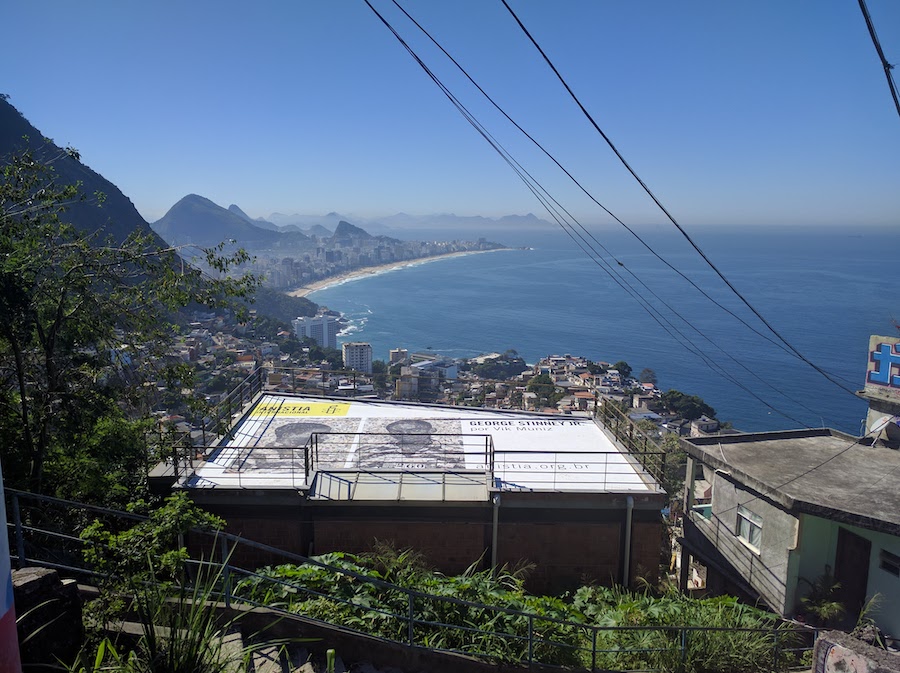
Vidigal, on the slopes of Morro Dois Irmãos and in between the swanky neighborhoods of Leblon and São Conrado, has also undergone significant urbanization and gentrification since the 2000s, with its superb views of the city and privileged location driving up the price of real estate.
There is no longer any significant drug dispute there, and one of the biggest industries in these areas is, in fact, favela tourism.
Rocinha Favela
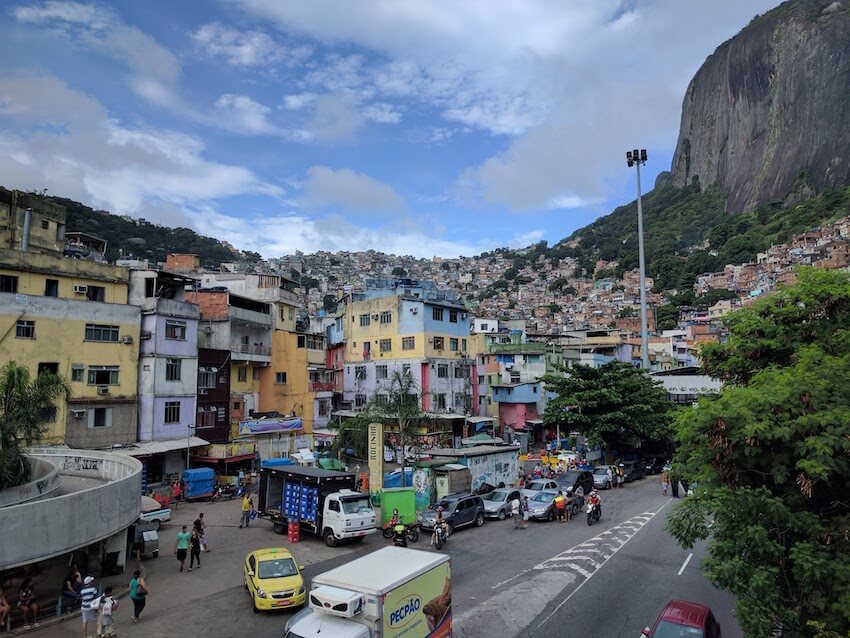
Rocinha Favela, Latin America’s largest favela, is a vibrant community nestled between the districts of São Conrado and Gávea. Home to around 200,0000 thousand residents, Rocinha’s narrow alleyways and multi-tiered buildings paint a vivid picture of life in Rio’s urban fringe.
Despite its socioeconomic challenges, Rocinha boasts a resilient community spirit and a thriving cultural scene. Its streets are alive with music, food stalls, and local businesses, reflecting the industriousness of its inhabitants. Rocinha is a testament to the stark economic disparities in Rio, yet it’s also a symbol of resilience, community strength, and the vibrant culture of Brazil’s urban spaces.
Why do some people disagree with Favela tours in Rio?
Some people believe that favela tours in Rio, or poor neighborhoods, can harm the communities. They worry about poverty tourism, saying it treats people like exhibits and can take advantage of them. They argue that some tours just let visitors gawk at the residents instead of promoting a true cultural exchange, which can upset the people who live there.
Critics also say that favela tourism can shock visitors and make them see the communities in a bad light. This criticism is especially aimed at companies not based in the favelas, as they might not care about showing the good sides of these communities or explaining the unique challenges and benefits of living there. As a result, these favela tours in Rio might spread negative ideas about favelas worldwide.
How to Choose The Best Tour Operator

Local people and tour operators have capitalized on people’s fascination with Rio de Janeiro’s favelas, and in Santa Marta, Rocinha and Vidigal they run a huge number of tours around the community, claiming they offer the reality of the slums and an enriching cultural experience.
Unfortunately, many of these tours can seem like sightseeing trips for people to see how less fortunate folks live. But if you do want to go on one of the favela tours in Rio mentioned above, there are specific things that you should take into consideration when choosing a tour.
1. Choose a Local Operator
A company that is based within the favela itself and only employs local residents offers one of the most sustainable ways of doing a tour. Guides from outside the area are not able to speak authentically for the inhabitants about life within the favelas.
Local guides are also able to delicately advise tourists on etiquette to ensure their visit isn’t too disruptive. This includes preventing photography which might include people who would not appreciate it.
This in-depth knowledge, tact and respect is what sets apart the best companies and is one of the most important aspects in minimizing the degree to which a tour becomes an annoyance for the locals.
2. Community Impact: Who benefits from Favela tours in Rio?
Favela tourism can be beneficial for the communities it touches. Many of the tour companies were founded within the favela itself and only employ guides that live there. Whilst this increases the safety and authenticity of the tours, it also ensures that the money is used to boost the local economy.
Increased exposure to the daily lives of the thousands of people that call favelas their home helps to dispel the myth propagated by the media that they are constant warzones to be avoided at all costs.
3. provide Educational Value
Beyond just sightseeing, a tour should provide a deep understanding of the favela’s history, culture, and the socio-economic dynamics that shape the community. It should cover the establishment of the favelas, their evolution over time, and the challenges they face today.
The tour should also highlight the resilience, creativity, and community spirit that thrive amidst these challenges. By fostering understanding and empathy, the tour can help dispel stereotypes and misconceptions about favela life.
4. Safety Concerns
Make sure to only book a tour led by experienced guides who are familiar with the area. They know the local customs and rules and can navigate the intricate layout of the favela, ensuring the tour avoids any potential areas of concern.
A reputable tour operator will prioritize guests’ safety, provide clear instructions, and address any concerns before the tour. It’s also advisable to read previous guests’ reviews to ensure the operator has a strong track record of safety.
Remember, safety also involves respecting the community’s norms and privacy to ensure a positive and respectful interaction between visitors and residents.
5. Smaller Group Size
The size of the tour group can significantly impact the quality of your experience during a favela tour. Smaller groups tend to offer a more intimate and personalized experience. With fewer people, you have more opportunities to interact with your guide, ask questions, and gain deeper insights.
It’s also less intrusive to the local community, reducing the feeling of being a spectacle. Additionally, smaller groups are more manageable, allowing guides to ensure everyone’s safety and comfort.
Warning: Avoid jeep Tours
On the other end of the scale, it is wise to avoid the controversial favela jeep tour companies, which ferry visitors through the favelas in safari jeeps. Not only are they almost exclusively based outside the favelas, but they also align the visit with adventure tourism.
Aside from being sensationalist, this has the potential effect of making residents feel like they’re in a zoo. These tours are satirized by the Rio-based comedy group Porta Dos Fundos in this video entitled ‘Poor’.
Favela Tours in Rio: Frequently Asked Questions
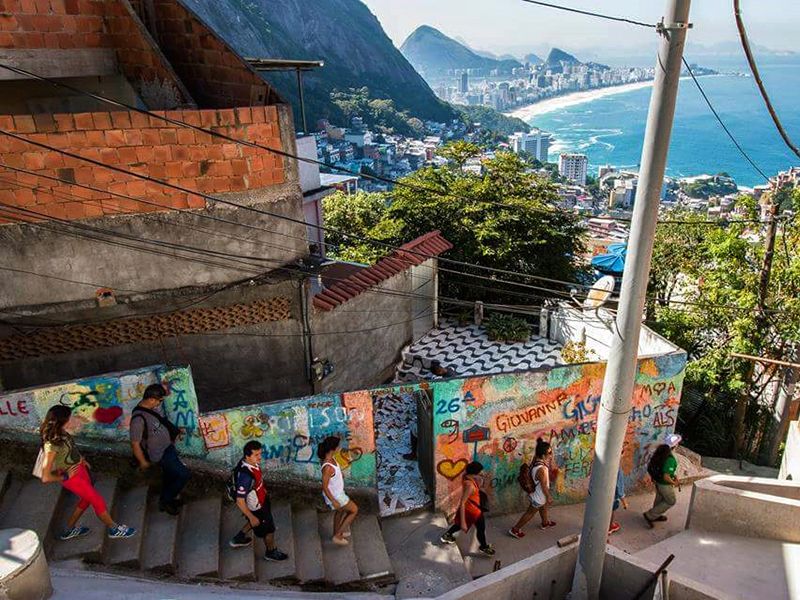
Is it safe to visit favelas in Rio?
Yes — it’s generally safe to visit favelas in Rio, especially with a guided tour. These tours are typically led by experienced local guides who understand the community and its dynamics.
However, like any urban area, favelas can have safety concerns, so it’s recommended to always be respectful, stay aware of your surroundings, and follow the guidance of your tour leader. It’s also advisable to choose a reputable tour operator with positive reviews regarding safety.
Which favela is best to visit in Rio de Janeiro?
Rocinha, being the largest favela in Brazil, is often recommended due to its vibrant culture and stunning views.
Vidigal is also popular, thanks to its friendly atmosphere and the breathtaking hike to the top of the Two Brothers Mountain.
For a cultural immersion, Santa Marta offers colorful buildings and street art, making it a favorite among visitors. Always choose a reputable tour for the best experience.
So the best favela to visit is a toss-up between Rocinha, Vidigal, and Santa Marta — depending on what you are looking fro.
Do people take guided tours of favelas in Brazil?
Yes — many people opt for guided tours when visiting favelas in Brazil. These tours are led by experienced guides, often locals who have a deep understanding of the community’s history and culture.
Guided tours not only provide important context and insights but also ensure visitors navigate these areas safely and respectfully.
They can also often contribute to the local economy, supporting community projects and businesses. Always opt for a tour that prioritizes ethical practices and community respect.
Is it safe to visit Rocinha favela?
Visiting Rocinha is generally considered safe when done responsibly, particularly through a guided tour.
These favela tours in Rio are conducted by experienced guides who are well-versed in the community’s dynamics. However, as with any urban area, it’s important to stay alert, follow the guide’s instructions, and respect local customs.
What favelas to avoid in Rio?
There are around 600 favelas in Rio de Janeiro. However, many of them, particularly those located outside of the Zona Sul (South Zone), are less frequented by tourists and may not be as prepared for visitors.
For safety and to respect the local communities, it’s not generally recommended to visit these favelas, specifically ones located in the North Zone of Rio de Janeiro. The Rio most dangerous favela are usually the ones in the North Zone.
Which favelas are the safest to visit?
When considering safety, the favelas in Rio de Janeiro most commonly visited by tourists are Rocinha, Vidigal, and Santa Marta.
These communities are more accustomed to visitors and often offer guided tours led by local residents or individuals with deep knowledge of the area.
These favela tours in Rio are designed to respect the community’s privacy and dignity while also providing a safe and enriching experience for tourists. However, safety can vary, so it’s always advisable to do research, read reviews, and choose a reputable tour operator.
Final Thoughts: Favela Tours in Rio
Favela tours in Rio de Janeiro, Brazil are not for everyone, but they offer vital insight into the city’s diverse culture and social fabric. When done with consent, respect, and a knowledgeable tour guide, these tours provide a deeper understanding of the living conditions in favelas.
Approached with an open mind, these tours can shed light on the realities beyond media portrayals, revealing the resilience and vibrancy within these communities. Becoming a key part of any Rio de Janeiro city tour, they offer unique perspectives often overlooked.
However, the choice to partake in a favela tour in Rio should be considered carefully, ensuring it’s done ethically and responsibly. In essence, if approached with the right attitude, favela tours in Rio can significantly deepen your understanding of this multifaceted city.

